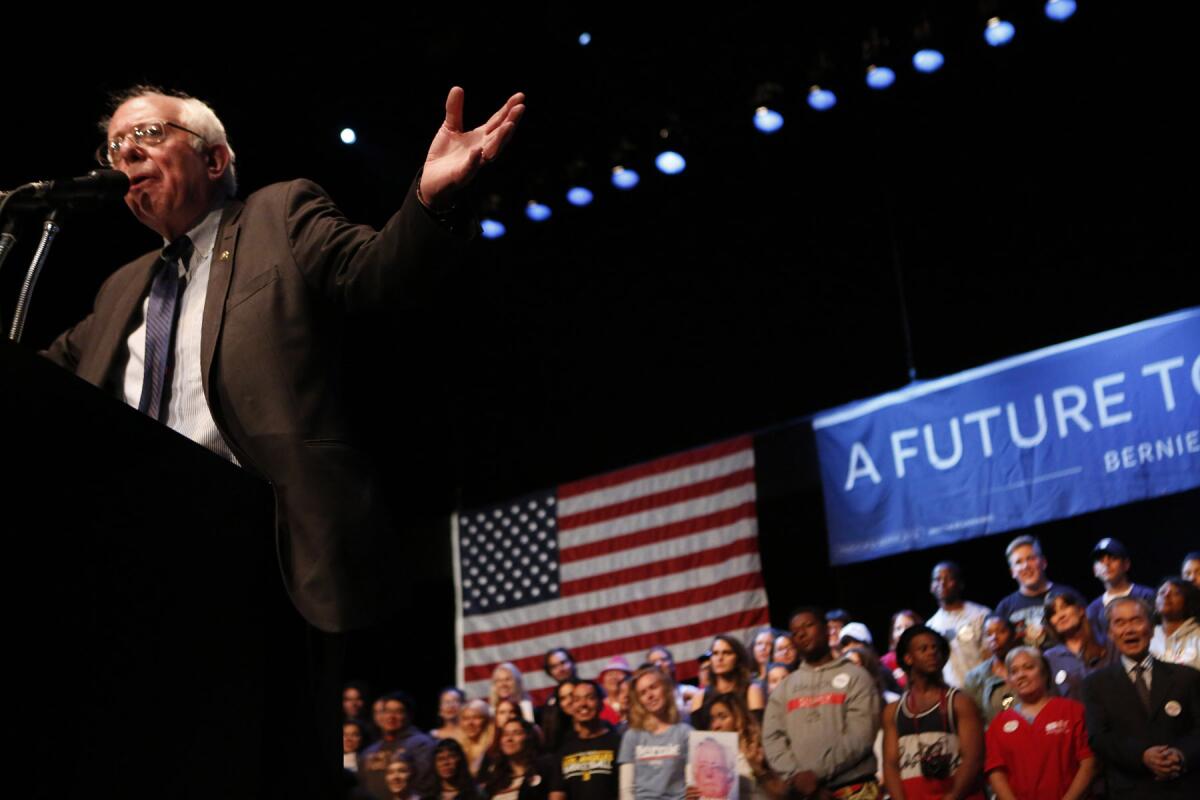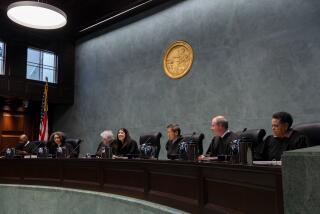Capitol Journal: When it comes to paying taxes, California is Bernie Sanders’ kind of state

Sen. Bernie Sanders would be a fan of California, where taxpayers pay more than their fair share, columnist George Skelton writes.
- Share via
reporting from Sacramento — Bernie Sanders wags his finger and shouts that the richest 1% should pay their fair share. No one can argue they aren’t already in California, at least in state taxes.
In fact, they’re forking over more than their fair share to Gov. Jerry Brown’s regime.
The latest figures have just been released, and the top 1% paid nearly half — 48% — of the state’s personal income taxes in 2014.
That’s pretty generous sharing. The other roughly half of the revenue came from 99% of the taxpayers. Well, not exactly all of them.
The bottom 60% were good for only 2% of the taxes. But the highest 10% contributed 79%, according to the state Franchise Tax Board.
OK, but the top 1% earned the most, right? Right. They earned about 24% of the income, but paid 48% of the taxes.
All but a few right-wingers support a progressive tax structure, with the rates rising as income climbs. But California’s tax goes beyond progressive. It’s almost perpendicular.
Brown may be embarrassed to remember this, but he ran for president in 1992 touting a federal flat tax with everyone paying the same 13% rate, regardless of income.
California’s governor turned 180 degrees 20 years later and won voter approval of a sock-the-rich plan that raised the highest state tax rates from 10.3% to 13.3%.
The current top federal income tax rate is 39.6%. Sanders has advocated lifting it to 54%. Nationally, the richest 1% pay 35% of federal income taxes.
In California, to reach the loftiest 1% requires an adjusted gross income of at least $556,638. Earnings of about $149,000 get you in the top 10%.
See more of our top stories on Facebook >>
So what’s wrong with California’s top 1% paying half the tax?
That is, besides ticking them off, prodding them to take their money and head for a more friendly state? Many claim that’s a myth. But a lot of us know people who have hit the road.
Here’s the real answer: It’s lousy fiscal policy.
The problem isn’t about fairness. It’s about stability — mainly the stability of programs that benefit the poor, such as healthcare and welfare. It also jeopardizes services for everyone: education and public safety.
When the inevitable recession circles back, it’s the flow of revenue from the rich that slows most. Their capital gains no longer soar, they sour.
California government leans heavily on capital gains, taxing them as ordinary income. That’s also what Sanders advocates for the federal government. The feds tax them at a lower rate.
In Sacramento, about 70% of the general fund revenue is projected to come from the state income tax in the next fiscal year. That’s way too much dependence on one levy. In 1950, the income tax generated only 10% of the general fund.
California’s economy has shifted from mainly manufacturing to service. But the tax code hasn’t kept up. The sales tax still applies mostly only to retail goods (for example, auto parts) and not service (auto repair labor). Consequently, the sales tax is projected to produce only about 22% of the general fund revenue next year. In 1950, it supplied 60%.
Here’s an example of the result: In 2008, as the economy began tanking, California’s gross domestic product fell by 3.7%. But tax revenue plummeted 23%. Sacramento was forced to butcher programs that still haven’t recovered.
Election 2016 | Live coverage on Trail Guide | Track the delegate race | Sign up for the newsletter
A Brown-sponsored rainy day fund approved by voters in 2014 should help slightly by committing some capital gains revenue to a budget reserve. But that’s just a very temporary, tiny patch.
What’s sorely needed is a thoughtful, thorough restructuring of the tax code: less reliance on the super-rich with their iffy incomes and extension of the sales tax to popular services. And perhaps some tweaking — heaven forbid — of the sacrosanct commercial property tax.
“When you tax the rich with the most progressive system, what you’re going to get is not just progressivity but volatility,” says state Controller Betty Yee, who created a study group that intends to issue a report soon.
“It makes fiscal management very, very difficult. We need a system that’s more sustainable, more predictable, more fair.”
State Sen. Robert Hertzberg (D-Van Nuys) also has been preaching reform.
“I’ve got one issue: How do we fix the zig and zag and create a stable, growing tax base that’s aligned with the economy,” he says.
One thing he suggests is a “consumption tax” that nails non-Californians who do business here.
But other than Yee and Hertzberg, there’s little political courage for any of this.
“I don’t see the path forward,” Brown said last year. It “may be logical [to] some green-eyeshade accountants, but I don’t know from a political point of view that it’s very viable.”
In fact, Democrats — not necessarily Brown — are being pushed in the opposite direction by the California Teachers Assn. It’s planning a November ballot initiative to extend Brown’s higher tax rates. They’re slated to expire at the end of 2018.
The tax hike was sold to voters as “temporary,” you’ll recall. Its advertised purpose was to tide schools over until the economy recovered. But public employee unions — and thus, Democrats — got addicted to the money: currently around $7.6 billion a year.
Sanders would love it. California seems more suited for the senator than Vermont. There, the highest state income tax rate is 8.95%, only roughly two-thirds of California’s.
Maybe Sanders should focus on making fellow Vermonters pay their “fair share” before trying to reform the country.
Follow @LATimesSkelton on Twitter
ALSO
Workers wonder whether Bernie Sanders’ fight for them will really help them compete
A truce between Bernie Sanders and Hillary Clinton? Not so fast.
More to Read
Get the L.A. Times Politics newsletter
Deeply reported insights into legislation, politics and policy from Sacramento, Washington and beyond. In your inbox three times per week.
You may occasionally receive promotional content from the Los Angeles Times.









